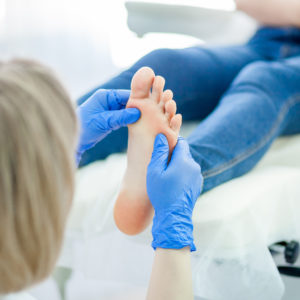Eligible for a Cartiva lawsuit?
Cartiva Failure Rates Higher Than Toe Implant Patients Were Led to Believe, Lawsuits Allege
Studies and reports have found Cartiva toe implants fail at rates much higher than the manufacturer disclosed, leading to a number of Cartiva lawsuits

- Cartiva toe implants were introduced in 2016, as a treatment alternative for big toe arthritis
- Manufacturers promoted the toe implant as safe and effective, indicating that the Cartiva failure rates were low
- Patient reports and studies have found Cartiva fails much more frequently than manufacturers suggested, leading to additional surgery and severe pain
- Patients are now pursuing Cartiva failure lawsuits alleging the manufacturers sold a defective and dangerous product
- FIND OUT IF YOU QUALIFY FOR A CARTIVA LAWSUIT
While the Cartiva implant was once hailed as a breakthrough alternative for patients facing big toe fusion surgery, many doctors are now moving away from the device, and some patients are now pursuing Cartiva lawsuits, alleging that the toe implant failure rate is much higher than the manufacturer disclosed, often resulting in additional follow up surgery.
Millions of people in the U.S. struggle with pain and limited mobility from cartilage deteriorating in the big toe joint, which is typically caused by repetitive trauma, severe bunion deformities or by hallux limitus or hallux rigidus, which are forms of big toe arthritis.
Those with these conditions often suffer daily pain, due to the loss of protective cartilage in the big toe joint, which is used and bends every time an individual takes a step. This can make even the most routine activities like standing difficult, and can be especially detrimental for those who live an active lifestyle.
Prior to 2016, doctors often recommended that many individuals with these conditions and symptoms undergo big toe fusion surgery, known as arthrodesis, to relieve the burden of living with daily pain caused by the deteriorated joint. However, for those living active lifestyles, arthrodesis has not always been a favorable option since it limits the mobility of the big toe by removing the joint and fusing bone.
The Cartiva Synthetic Cartilage Implant (SCI) was introduced as a “revolutionary” treatment option for these patients, and quickly became a popular alternative after it was given premarket approval as a Class III medical device by the FDA in 2016,

Learn More About
Lawyers are reviewing Cartiva lawsuits for individuals who experienced complications after receiving the toe implant. Settlement benefits may be available.
Learn More About this Lawsuit SEE IF YOU QUALIFY FOR COMPENSATIONCartiva Inc. marketed the big toe implant for treatment of traumatic and arthritic conditions in the big toe joint, by removing the joint and replacing it with the Cartiva implant, which was intended to provide cushioning between the toe bones.
While podiatrists across the nation quickly adopted the use of Cartiva for their patients based on the manufacturers advertised benefits and the indication that it would provide patients with an option to relieve pain and resume active lifestyles, concerns have emerged that doctors were misled about the Cartiva failure rates and many patients have been left very dissatisfied with the results of the big toe implant.
Cartiva Implant Failure Reports
Within just a couple years of the implants release, patients and doctors began reporting unexpected complications from Cartiva surgery. A series of Cartiva lawsuits have now been filed alleging that the manufacturers drastically underestimated the rate and severity of problems experienced by users.
In what can be seen across multiple social media platforms, individuals are voicing stories about their experiences with Cartiva implants failing to provide much, if any, toe pain relief, while others have expressed their dissatisfaction over the secondary complications caused by failing implants, causing many to wear orthopedic boots for extended periods of time and even requiring the need for revisions and toe fusion surgeries.
Concerns have been raised about Cartiva’s unexpected high rates of failures, with one of the largest and most advanced foot and ankle care providers in the country, the Foot and Ankle Institute, outright stating patients should not get a Cartiva implant.
In a blog posted by one of the Institute’s Board-Certified Podiatric Foot and Ankle Specialists, Dr. Bob Baravarian stated he has seen about 50% of Cartiva implants fail in patients, resulting in the need to remove the Cartiva SCI and replace it with other options.
Dr. Bavarian indicates the Cartiva implant failure issue is an “epidemic problem”, and that the manufacturer should be required to investigate why the implant fails at rates higher than previously reported in clinical studies.
Studies Linking Cartiva to High Failure Rates
Cartiva was first approved on the basis of a clinical study known as the Motion Study, which found an “equivalence” to big toe fusion and Cartiva implants, with a failure rate at only 13%.
Following real-world use of the device, a study was published in the American Orthopaedic Foot and Ankle Society in November 2020, which found that patients receiving the implant for the treatment of hallux rigidus actually experienced a 64% Cartiva failure rate within four weeks of surgery. The study found that number increased drastically to 79% at 19 months post-surgery.
The most common reason for the Cartiva failures was subsidence, which is a painful condition where the implant slips into the bone.
Another study published this month found Cartiva patients reported higher post-operative pain than those receiving alternative procedures. The results were similar to the findings published in a 2019 study, which found 30% of Cartiva SCI recipients were either dissatisfied or very dissatisfied with the outcomes of the procedure.
Cartiva Failure Lawsuits
Many individuals experiencing a failed Cartiva implant have been left to suffer pain for extended periods of time before receiving yet another surgery to fix the problems caused by the Cartiva toe implant.
Some have even reported the Cartiva failure has left them in a worse position, due to the amount of bone that was removed during the toe implant surgery. In this scenario, patients have been left with significantly shorted big toes, which can lead to additional foot injuries from the offloading effect.
Such poor patient outcomes have left many seeking compensation from the manufacturer through the filing of a Cartiva lawsuit, alleging that the manufacturer did not uphold their duty to adequately investigate the devices were safe and failed to warn patients about the increased risk of implant failure.
Last month, Cathy Atkinson filed a Cartiva failure lawsuit against Stryker, Wright Medical and Cartiva, Inc., indicating that she experienced problems only two years after undergoing big toe implant surgery in November 2018. As a result of the implant failure, she had to undergo revision surgery to have Cartiva removed in December 2020, and underwent arthrodesis fusion surgery in 2021.
As a result, lawyers are now reviewing potential Cartiva lawsuits against the manufacturer to pursue settlement payouts for individuals over their injuries, lost income and pain and suffering endured by the failing implant.

Do You Qualify For a Cartiva Lawsuit?
Lawyers are providing free consultations and claim evaluations to help determine if settlement benefits may be available as a result of a Cartiva failure. Lawsuits are pursued on a contingency fee basis, where there are no fees or expenses unless a recovery is obtained.
Get more articles like this sent directly to your inbox.
"*" indicates required fields






0 Comments